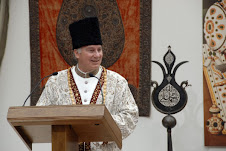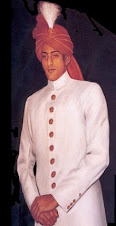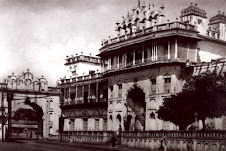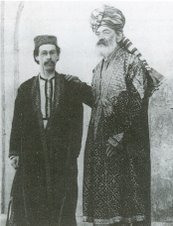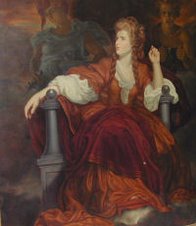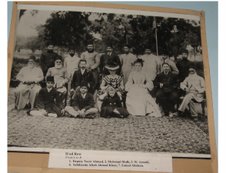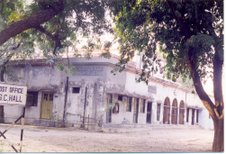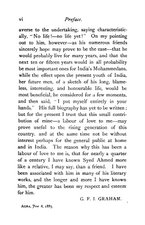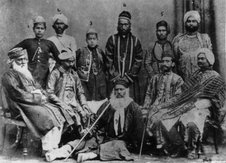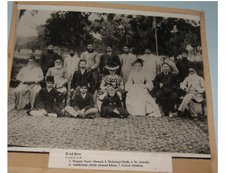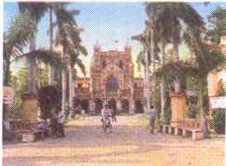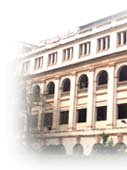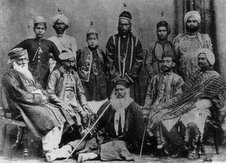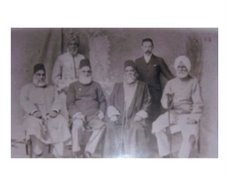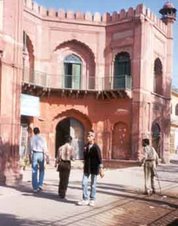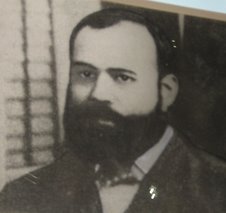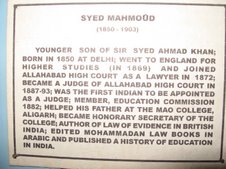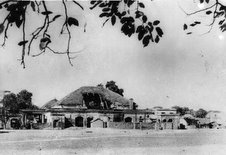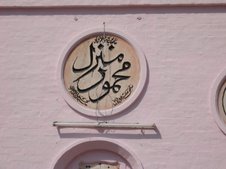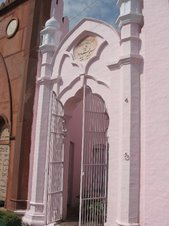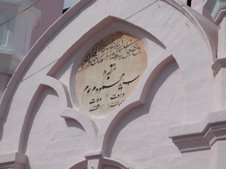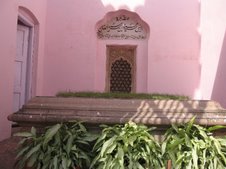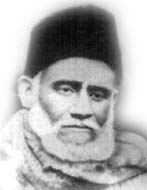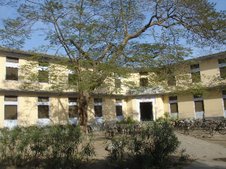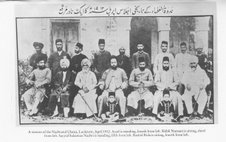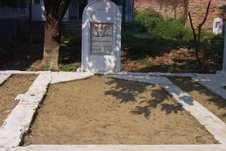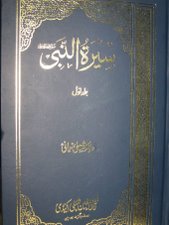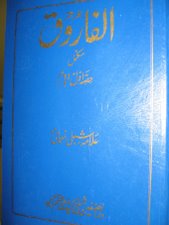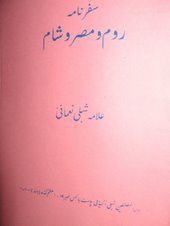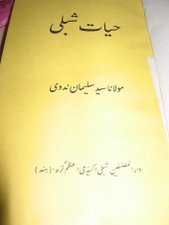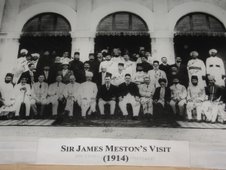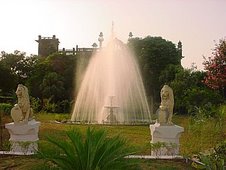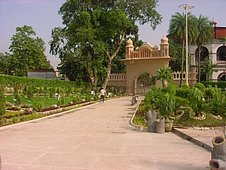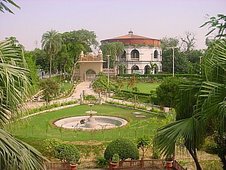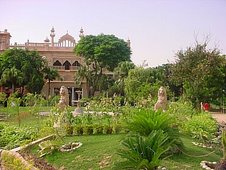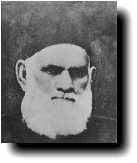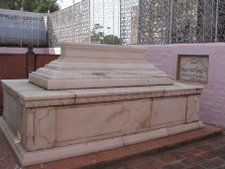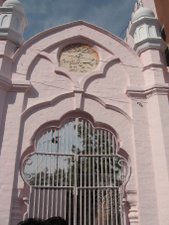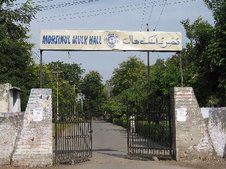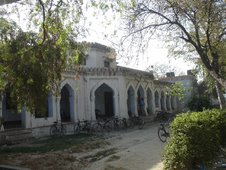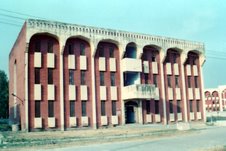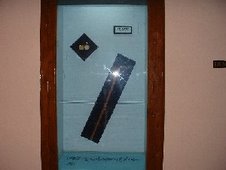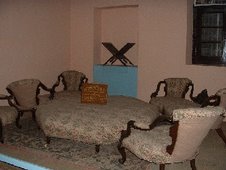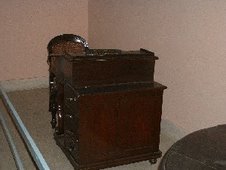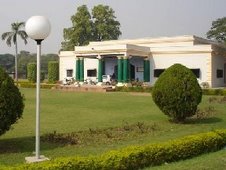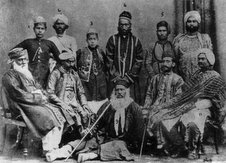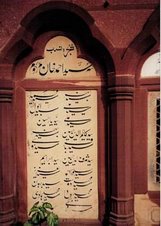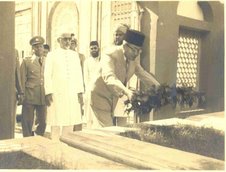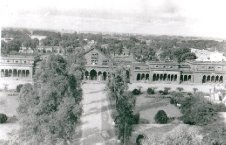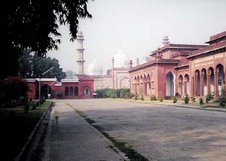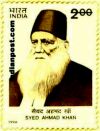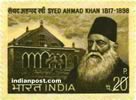Justice Syed Mahmud
Justice Syed Mahmud
Father’s Name: Sir Syed Ahmad Khan
Mother’s Name: Parsa Begum
Date of birth: May 24, 1850 Delhi
Died: May 8, 1903 in Sitapur
Buried in AMU Jama Masjid
Father’s Name: Sir Syed Ahmad Khan
Mother’s Name: Parsa Begum
Date of birth: May 24, 1850 Delhi
Died: May 8, 1903 in Sitapur
Buried in AMU Jama Masjid
Hony. Jt. Secretary MAO College Board : 1887-1898
Secretary MAO College Board : 1898-98
President MAO College Board of Trutees: 1898-1903
Books: A History of English Education in India
Law of Evidence in British India
Mohammadan Law Book (Arabic)
Justice Syed Mahmud, among the first Indians to study at Cambridge University, a British barrister and High Court Judge in India, played a major role in the formulation of "Anglo-Muhammadan Law," the synthesis of Islamic and British jurisprudence that remains influential in much of the Muslim world.
Syed Mahmud was the second son of Sir Syed Ahmad, the first being Syed Hamid. He was born at Delhi on May 24, 1850 and was taught at home. Persian was his favourite subject and later he founded a Persian Society at the MAO College. He accompanied Syed Ahmad wherever he was transferred and got his schooling in Moradabad and Ghazipur schools founded by his father. Finally he joined the Queen’s College Benaras.
In 1869 he was awarded a Government scholarship for higher studies in England. At that time Syed was also willing to visit England to study the English educational pattern and to write Khutbat-e-Ahmadiya, a reply to Sir William Muir’s misleading book ‘The life of Mohamet’. Both father and son sai1ed by the same ship and had to jointly study things relevant to the development of Muslim community. He was admitted to the Christ College, Cambridge and secured the first rank in English literature. In 1872 he got the degree of Bar-at-Law and was called to the Bar at Lincoln’s Inn.
Contrary to the culture of sycophancy and genuflecting before the colonial English authority promoted by the British and freely adopted by the Indians at that time, both Syed Ahmad Khan and his high-profile and brilliant son Syed Mahmud strived to conduct themselves as if they were equal to the English. Syed Ahmad Khan hosted a dinner at Banaras in 1872 to honour Syed Mahmud when he returned from England after having been called to the bar at Lincoln’s Inn. Alexander Shakespeare, Commissioner of Banaras, presided. While responding to Shakespeare’s toast, Syed Mahmud spoke of his wish to unite England and India socially even more than politically. The English rule in India, in order to be good, must promise to be eternal; and it can never do so until the English people are known to us as friends and fellow subjects, than as rulers and conquerors. The Pioneer, where report of this dinner was published, doesn’t record the alarm that Shakespeare and other Englishmen present must have felt at this. But Syed Mahmud had made his point. And he made it again when, on becoming a High Court Judge at Allahabad (1882) at the young age of 32, he submitted a Memorial to Government to the effect that since he was English except in name and parentage, he should be treated on par with British judges. (Syed Mahmud’s English contemporaries said that his mastery of English idiom was of an incredible precision.)
Law Career:
As a young lawyer, he worked under the supervision of Moulvi Samiullah, a close associate of Sir Syed who was then living at Allahabad. His legal acumen was appreciated by Sir Salar Jung I of Hyderabad who called him on a monthly salary of Rs.2000/- (Two Thousand) for editing the laws and reform the judicial administration. In 1879 he was appointed a District Judge at Rae Bareli and took some controversial decisions which won admiration from the higher judicial authorities His interpretation of law in Deputy Commissioner v. Raja Ram Pal Singh was so decisive that the Judicial Committee of the Privy Council upheld his opinion (in the Privy Council appeal No.3 1882) and in view of his profound erudition recommended the Governor-General for his promotion to the higher rank to which he deserved. Consequently Syed Mahmud was elevated to the Allahabad High Court in 1882 at the age of 32. He was the first Indian Judge of the Allahabad High Court.
He had a perfect command over the Laws and differed in the interpretation of his fellow English judges and thus incurred their displeasure and resigned in 1893 because of differences between him and the Chief Justice. He was a great authority on Hindu and Muslim Laws and me of his pronouncements are still regarded as classics.
Role in Aligarh Movement:
From the outset of the movement Syed Mahmud was the chief advisor of his father in all his schemes of education and national-building activities. They were unanimous in their opinion that the western education was the immediate necessity for the Muslims and when they proceeded to England and stayed there together, there was practically no moment when they had not discussed the crucial question of the foundation of a university for the Muslims in India. Syed Ahmad knew little English and all his correspondence was taken by Syed Mahmud. Since he had taken the appointment in judiciary he had very meager time to stay with his father who always regretted his absence from Aligarh.
Syed Mahmud drafted and published in England the first appeal to the Indian Muslims for modern education. He drafted the constitution Khwast-garan-e-Taraqqi-e-Talim-e Musalmanan which was to assess the attitude of the Muslims towards English education. Syed Mahmud also prepared a questionnaire to responsible Muslims to know their opinions on the causes of Muslim backwardness and also to suggest remedy.
While Syed Mahmud was, still in England brisk correspondence was taking place between him and Syed regarding the formation of the College Fund Committee and he was made a member of it. Before leaving England, he was the man who drew the whole scheme of education for the Indian Muslims. He had even sketched the structure of the building like Strachey Hall and Sir Syed Hall for the proposed College. He wanted, like Syed, a University free from the Government control, a perfect residential system, in which the students of both the communities lived together adhering to their faiths. Though Syed Mahmud while High Court judge lived at Allahabad yet he looked after the appointment of teachers, academic standards, Finance and official correspondence and it surprises one as to how he spared time along with his lofty judicial position to look into all this. Syed’ s every dream regarding Muslim uplift was given a practical shape by Syed Mahmud and how much the Aligarh Movement owes to his untiring efforts is very difficult of assess.
Syed Mahmud was obliged to resign his judgeship (1893). Syed Ahmad Khan issued a long statement to an Urdu newspaper on that occasion, asserting that the main reason why Syed Mahmud couldn’t continue in the service was that the English rob their Indian civil servants of their “self-respect”. The circumstances that forced Justice Mahmud to seek premature retirement from the Judgeship of the Allahabad High Court, have for long remained the subject of speculation. Some have characterised these circumstances as "sad",1 without explaining as to why they regard them so; others have attributed Justice Mahmud's resignation to his differences with Chief Justice Sir John Edge, without explaining the nature of these differences.
After his retirement in 1893 he devoted solely to the development of Mohammadan Anglo-Oriental College, Aligarh. He taught English literature in the College and always thought of better relations between the teachers and students. He was a very active member of the Mohammadan Educational Conference and assisted his father in programming the sessions of the Conference. Syed Ahmad eulogizing his services confessed that ‘had he (Syed Mahmud) not helped me, my visit to England have been a failure’. There was no man who knew plans of Syed Ahmad more accurately than Syed Mahmud who was a true replica of his father
Syed Ahmad was always pensive as to what would be of the College when he was no more. But he was always contended when he looked to Syed Mahmud who knew his every plan and had the capacity to implement them. Sir Syed had great confidence in Syed Mahmud and he wished him to be his successor. That is why he got him appointed as Honorary Joint Secretary of the MAO College in 1887. He wanted that his policies regarding the College be continued and for that there was no better successor than his son. Therefore under the Trustees Regulation, Syed Ahmad got Syed Mahmud nominated in 1889 as the life Honorary Secretary after his death. But some senior colleagues of Syed Ahmad did not like this and his nomination was opposed. Syed Mahmud’s leniency towards the European Staff was the main issue in his opposition. When Syed Ahmad died on March 27, 1898, Syed Mahmud held the office of the Honorary Secretary of the College. Later after much persuasion, he accepted the Presidentship of Trustees which empowered him only to preside over the meetings of the Trustees.
In 1895 he wrote a book “A History of English Education in India”, which gives lengthy quotations from government documents and statistical data.
By 1896, his health deteriorated and he died in 1903 at Sitapur. The dead body was brought to Aligarh and he was laid to rest beside his father in the courtyard of the Jama Masjid of the University. Thus there lies buried a man who from his young age thought of a University, lived with it and died for it.
Justice Syed Mahmud, among the first Indians to study at Cambridge University, a British barrister and High Court Judge in India, played a major role in the formulation of "Anglo-Muhammadan Law," the synthesis of Islamic and British jurisprudence that remains influential in much of the Muslim world.
Syed Mahmud was the second son of Sir Syed Ahmad, the first being Syed Hamid. He was born at Delhi on May 24, 1850 and was taught at home. Persian was his favourite subject and later he founded a Persian Society at the MAO College. He accompanied Syed Ahmad wherever he was transferred and got his schooling in Moradabad and Ghazipur schools founded by his father. Finally he joined the Queen’s College Benaras.
In 1869 he was awarded a Government scholarship for higher studies in England. At that time Syed was also willing to visit England to study the English educational pattern and to write Khutbat-e-Ahmadiya, a reply to Sir William Muir’s misleading book ‘The life of Mohamet’. Both father and son sai1ed by the same ship and had to jointly study things relevant to the development of Muslim community. He was admitted to the Christ College, Cambridge and secured the first rank in English literature. In 1872 he got the degree of Bar-at-Law and was called to the Bar at Lincoln’s Inn.
Contrary to the culture of sycophancy and genuflecting before the colonial English authority promoted by the British and freely adopted by the Indians at that time, both Syed Ahmad Khan and his high-profile and brilliant son Syed Mahmud strived to conduct themselves as if they were equal to the English. Syed Ahmad Khan hosted a dinner at Banaras in 1872 to honour Syed Mahmud when he returned from England after having been called to the bar at Lincoln’s Inn. Alexander Shakespeare, Commissioner of Banaras, presided. While responding to Shakespeare’s toast, Syed Mahmud spoke of his wish to unite England and India socially even more than politically. The English rule in India, in order to be good, must promise to be eternal; and it can never do so until the English people are known to us as friends and fellow subjects, than as rulers and conquerors. The Pioneer, where report of this dinner was published, doesn’t record the alarm that Shakespeare and other Englishmen present must have felt at this. But Syed Mahmud had made his point. And he made it again when, on becoming a High Court Judge at Allahabad (1882) at the young age of 32, he submitted a Memorial to Government to the effect that since he was English except in name and parentage, he should be treated on par with British judges. (Syed Mahmud’s English contemporaries said that his mastery of English idiom was of an incredible precision.)
Law Career:
As a young lawyer, he worked under the supervision of Moulvi Samiullah, a close associate of Sir Syed who was then living at Allahabad. His legal acumen was appreciated by Sir Salar Jung I of Hyderabad who called him on a monthly salary of Rs.2000/- (Two Thousand) for editing the laws and reform the judicial administration. In 1879 he was appointed a District Judge at Rae Bareli and took some controversial decisions which won admiration from the higher judicial authorities His interpretation of law in Deputy Commissioner v. Raja Ram Pal Singh was so decisive that the Judicial Committee of the Privy Council upheld his opinion (in the Privy Council appeal No.3 1882) and in view of his profound erudition recommended the Governor-General for his promotion to the higher rank to which he deserved. Consequently Syed Mahmud was elevated to the Allahabad High Court in 1882 at the age of 32. He was the first Indian Judge of the Allahabad High Court.
He had a perfect command over the Laws and differed in the interpretation of his fellow English judges and thus incurred their displeasure and resigned in 1893 because of differences between him and the Chief Justice. He was a great authority on Hindu and Muslim Laws and me of his pronouncements are still regarded as classics.
Role in Aligarh Movement:
From the outset of the movement Syed Mahmud was the chief advisor of his father in all his schemes of education and national-building activities. They were unanimous in their opinion that the western education was the immediate necessity for the Muslims and when they proceeded to England and stayed there together, there was practically no moment when they had not discussed the crucial question of the foundation of a university for the Muslims in India. Syed Ahmad knew little English and all his correspondence was taken by Syed Mahmud. Since he had taken the appointment in judiciary he had very meager time to stay with his father who always regretted his absence from Aligarh.
Syed Mahmud drafted and published in England the first appeal to the Indian Muslims for modern education. He drafted the constitution Khwast-garan-e-Taraqqi-e-Talim-e Musalmanan which was to assess the attitude of the Muslims towards English education. Syed Mahmud also prepared a questionnaire to responsible Muslims to know their opinions on the causes of Muslim backwardness and also to suggest remedy.
While Syed Mahmud was, still in England brisk correspondence was taking place between him and Syed regarding the formation of the College Fund Committee and he was made a member of it. Before leaving England, he was the man who drew the whole scheme of education for the Indian Muslims. He had even sketched the structure of the building like Strachey Hall and Sir Syed Hall for the proposed College. He wanted, like Syed, a University free from the Government control, a perfect residential system, in which the students of both the communities lived together adhering to their faiths. Though Syed Mahmud while High Court judge lived at Allahabad yet he looked after the appointment of teachers, academic standards, Finance and official correspondence and it surprises one as to how he spared time along with his lofty judicial position to look into all this. Syed’ s every dream regarding Muslim uplift was given a practical shape by Syed Mahmud and how much the Aligarh Movement owes to his untiring efforts is very difficult of assess.
Syed Mahmud was obliged to resign his judgeship (1893). Syed Ahmad Khan issued a long statement to an Urdu newspaper on that occasion, asserting that the main reason why Syed Mahmud couldn’t continue in the service was that the English rob their Indian civil servants of their “self-respect”. The circumstances that forced Justice Mahmud to seek premature retirement from the Judgeship of the Allahabad High Court, have for long remained the subject of speculation. Some have characterised these circumstances as "sad",1 without explaining as to why they regard them so; others have attributed Justice Mahmud's resignation to his differences with Chief Justice Sir John Edge, without explaining the nature of these differences.
After his retirement in 1893 he devoted solely to the development of Mohammadan Anglo-Oriental College, Aligarh. He taught English literature in the College and always thought of better relations between the teachers and students. He was a very active member of the Mohammadan Educational Conference and assisted his father in programming the sessions of the Conference. Syed Ahmad eulogizing his services confessed that ‘had he (Syed Mahmud) not helped me, my visit to England have been a failure’. There was no man who knew plans of Syed Ahmad more accurately than Syed Mahmud who was a true replica of his father
Syed Ahmad was always pensive as to what would be of the College when he was no more. But he was always contended when he looked to Syed Mahmud who knew his every plan and had the capacity to implement them. Sir Syed had great confidence in Syed Mahmud and he wished him to be his successor. That is why he got him appointed as Honorary Joint Secretary of the MAO College in 1887. He wanted that his policies regarding the College be continued and for that there was no better successor than his son. Therefore under the Trustees Regulation, Syed Ahmad got Syed Mahmud nominated in 1889 as the life Honorary Secretary after his death. But some senior colleagues of Syed Ahmad did not like this and his nomination was opposed. Syed Mahmud’s leniency towards the European Staff was the main issue in his opposition. When Syed Ahmad died on March 27, 1898, Syed Mahmud held the office of the Honorary Secretary of the College. Later after much persuasion, he accepted the Presidentship of Trustees which empowered him only to preside over the meetings of the Trustees.
In 1895 he wrote a book “A History of English Education in India”, which gives lengthy quotations from government documents and statistical data.
By 1896, his health deteriorated and he died in 1903 at Sitapur. The dead body was brought to Aligarh and he was laid to rest beside his father in the courtyard of the Jama Masjid of the University. Thus there lies buried a man who from his young age thought of a University, lived with it and died for it.






